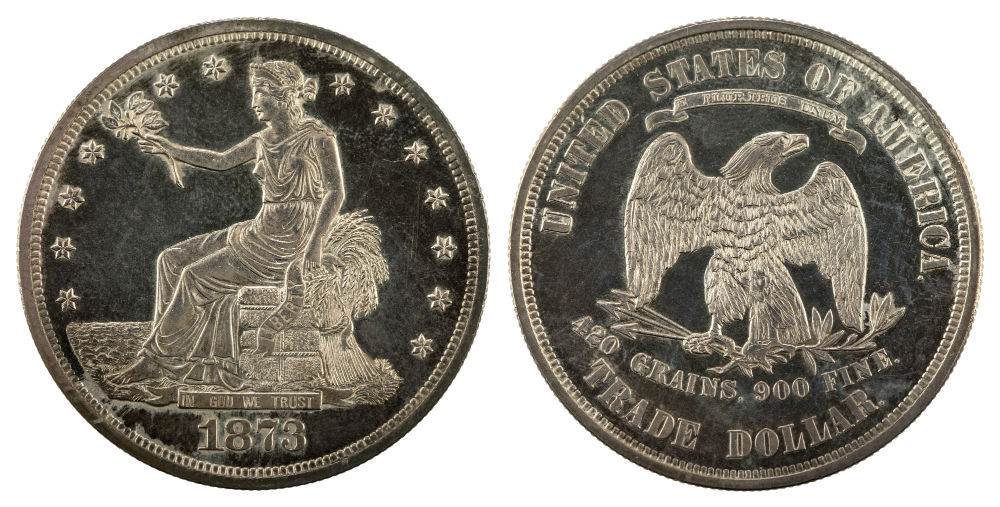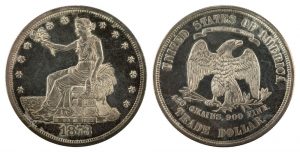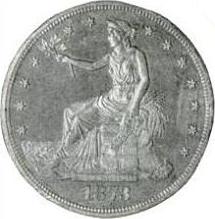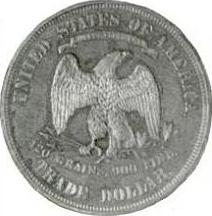The Trade Dollar


Being one of the shortest-lived series in the history of the American Numismatics, coin collectors have been enjoying collecting Trade Dollars. Because Silver Coins, including the Trade Dollars, were big, fun to collect and not to mention having a high Silver Content only adds to the thrill of the hunt. Before, these called Commercial Dollars since these were meant to be used as money for export, but were soon coined as Trade Dollars.
History of the Trade Dollar
In the early 1870s, the United States has been having problems with international commerce, specifically, in China. China has always favored the Eight Reale or the Mexican Peso due to its high silver content. During this type, the US have been using Liberty Dollars which were hesitantly accepted by China during the trade. Not only that – these are accepted at a discounted price only to be melted afterward.
The reason for this was the Liberty Dollar have a lesser amount of Pure Silver content and a lesser fineness on it. Merchants in China were able to recognize this, thus favoring the obvious choice – the Mexican Peso. The Congress needed to make a decision, and fast, so the US Treasury Department created a coin that will be used for international trade. Thus, the Act of Feb. 12, 1873, was born.
It was in 1873 that the first Trade Dollar was minted, with the purpose of competing with the Mexican Dollar. It was designed by US Mint Chief Engraver William Barber and a large number of the Trade Dollar were minted at the Philadelphia Mint. Majority of the Trade Dollars minted during 1873-1874 were mostly used for commercial trade. Chinese merchants have tried and tested the authenticity of the Trade Dollar, which is why many of these silver dollars had chop marks indicating their personal trademarks in Chinese Characters.
The Trade Dollar features Miss Liberty facing right while the reverse features an Eagle clutching an olive branch and three arrows using its talons. It was slightly heavier than the regular silver dollar, weighing 420 grains and with a fineness of .900.
The Trade Dollar was minted from July 1873 up to April 1878. During 1873-1874 the first 2 years of the production of Trade Dollars were used for trade in the Orient. It was intended for international commerce but was also used as a legal tender – amounting up to $5 for about four years.
By 1875, these were used more in the US. There are some who bought Trade Dollars with the purpose of using them for their bullion value – these are employers who used the Trade Dollars for their face value as payment for their workers. As a result, the workers suffered as the Trade Dollars were either accepted for their bullion value, a lower price or worse, refused.
In 1876 the price of Silver has already declined, resulting to a huge amount of Trade Dollars to be sent back to the US. By 1878, the Sherman Silver Act was passed thanks to John Sherman. This Act mandated to stop the production of Trade Dollars. No business strike Trade Dollars were struck at this time – only Proof coins. Congress has already canceled the authorization given to the Trade Dollar, and eventually, unblemished Trade Coins were retrieved.
The Detailed Specification of the Trade Dollar

The Trade Dollar was designed by William Barber. It weighs approximately 27.20 grams, has a reeded edge, is 38.10 in diameter and is made up of 90% Silver and 10% Copper. Trade Dollars were minted from 1873-1875 in US Mints located in Philadelphia, San Francisco, and Carson City. The largest Trade Dollar producing mint was the Philadelphia Mint, while the Carson City Mint has the lowest mintages.

For the obverse, Miss Liberty is seen seated on a bale or merchandise, facing right. On her left hand is a ribbon where the word LIBERTY was inscribed with a wheat sheaf behind it and the sea in front. On her right hand, she is holding an olive branch. IN GOD WE TRUST was written on the foot of the bale, the date below it and 13 stars surrounding Miss Liberty in a form of an arc.

For the reverse, a perched, Bald Eagle is holding three arrows and an olive branch on its talons. A ribbon above the Eagle read E PLURIBUS UNUM, and the legend UNITED STATES OF AMERICA in a form of an arc lays above the Eagle and ribbon. 420 GRAINS, 900 Fine are written just below the Eagle, followed by the mintmark if any (CC for Carson City, S for San Francisco while Philadelphia bears no mintmark) and the words TRADE DOLLAR on the lowest part of the coin.
The following are the Regular Strikes of the Trade Dollar
1873 Trade Dollar – 396,635 coins minted at the Philadelphia Mint
1873-CC Trade Dollar – 124,500 coins minted at the Carson City Mint
1873-S Trade Dollar – 703,000 coins minted at the San Francisco Mint
1874 Trade Dollar – 987,100 coins minted at the Philadelphia Mint
1874-CC Trade Dollar – 1,373,200 coins minted at the Carson City Mint
1874-S Trade Dollar – 2,549,000 coins minted at the San Francisco Mint
1875 Trade Dollar – 218,200 coins minted at the Philadelphia Mint
1875-CC Trade Dollar – 1,573,700 coins minted at the Carson City Mint
1875-S Trade Dollar – 4,487,000 coins minted at the San Francisco Mint
1875-S S/CC Over mintmark Trade Dollar – 4,487,000 coins minted at the San Francisco Mint
1876 Trade Dollar – 455,000 coins minted at the Philadelphia Mint
1876-CC Trade Dollar – 509,000 coins minted at the Carson City Mint
1876-S Trade Dollar – 5,227,000 coins minted at the San Francisco Mint
1877 Trade Dollar – 3,039,200 coins minted at the Philadelphia Mint
1877-CC Trade Dollar – 534,000 coins minted at the Carson City Mint
1877-S Trade Dollar – 9,519,000 coins minted at the San Francisco Mint
1878-CC Trade Dollar – 97,000 coins minted at the Carson City Mint
1878-S Trade Dollar – 4,162,000 coins minted at the San Francisco Mint
The following are Proofs Trade Dollar
1873 Trade Dollar (Proof) – 865 coins minted at the Philadelphia Mint
1874 Trade Dollar (Proof) – 700 coins minted at the Philadelphia Mint
1875 Trade Dollar (Proof) – 700 coins minted at the Philadelphia Mint
1876 Trade Dollar (Proof) – 1,150 coins minted at the Philadelphia Mint
1877 Trade Dollar (Proof) – 510 coins minted at the Philadelphia Mint
1878 Trade Dollar (Proof) – 900 coins minted at the Philadelphia Mint
1879 Trade Dollar (Proof) – 1,541 coins minted at the Philadelphia Mint
1880 Trade Dollar (Proof) – 1,987 coins minted at the Philadelphia Mint
1881 Trade Dollar (Proof) – 960 coins minted at the Philadelphia Mint
1882 Trade Dollar (Proof) – 1,097 coins minted at the Philadelphia Mint
1883 Trade Dollar (Proof) – 979 coins minted at the Philadelphia Mint
1884 Trade Dollar (Proof) – 10 coins minted at the Philadelphia Mint
1885 Trade Dollar (Proof) – 5 coins minted at the Philadelphia Mint
Collecting Trade Dollars
When it comes to Trade Dollars, it is important to note that the places to look for wear are Miss Liberty’s ear, breast, and her left knee, as well as the head of the Eagle and its left wing.
Prices for regular strike coins range from $60.00 to $250,000.00 depending on the rarity and grade of the coin. For Proofs, prices range from $1,000.00 up to $3,750,000.00.
Great finds are the Trade Dollars dated 1873, 1873-CC, 1874, 1874-CC, 1875, 1875-S, 1876, 1876-CC, 1877-CC, 1878-CC and 1878-S – the 1878-CC Trade Dollar being the rarest of them all.
The Ultra Rare Trade Dollars most sought-after by coin collectors are the 1884 (Proof) and 1885 (Proof). There are only 10 known 1884 Proofs and 5 1885 Proofs known to exist. These two proofs were kept and minted in secret by the US Mint, and it wasn’t only when
According to PCGS, 1884 Proof Trade Dollars are worth $450,000.00-$1,250,000.00. As for 1885 Proofs, price ranges from $1,750,000.00-$3,750,000.00. For a price guide on PCGS-graded Trade Dollar Coins, you use this link.
References:
PCGS, PCGS CoinFacts, NGC Coin, tradedollars.net, Coin Week
